OLDSMOBILE BRAVADA 1998 User Guide
Manufacturer: OLDSMOBILE, Model Year: 1998, Model line: BRAVADA, Model: OLDSMOBILE BRAVADA 1998Pages: 380, PDF Size: 19.2 MB
Page 11 of 380
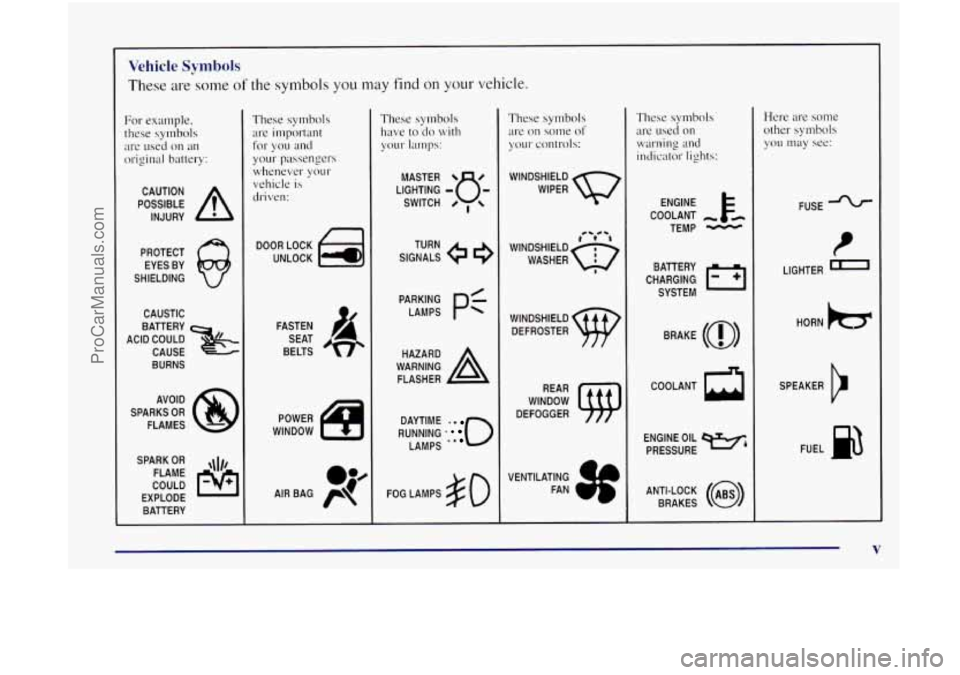
Vehicle Symbols
These are some of the symbols you may find on your vehicle.
For example,
these symbols
are used on
an
original battery:
POSSIBLE A
CAUTION
INJURY
PROTECT EYES BY
SHIELDING
CAUSTIC
ACID COULD
x
BATTERY
CAUSE
BURNS
AVOID
SPARKS
OR
FLAMES
SPARK
OR ,\I/,
COULD
FLAME
EXPLODE BATTERY
These symbols
are important
your passengers
whenever your
vehicle
is
driven:
for
you and
FASTEN
SEAT
BELTS
These symbols
have
to do with
your lamps:
SIGNALS 9
TURN
RUNNING
' 0
DAYTIME .
LAMPS **
FOG LAMPS $0
These symbols
are on some
of
your controls:
WINDSHIELD
WIPER
CS 0b
WINDSHIELD DEFROSTER
WINDOW
DEFOGGER
VEN TlLATlNG
FAN
These symbols are
used on
warning and
indicator lights:
COOLANT -
TEMP -
CHARGING BAllERY
SYSTEM
BRAKE
(0)
COOLANT a
ENGINE OIL w,
PRESSURE
Here are some
other symbols
you may see:
FUSE
LIGHTER
n
HORN )tr
SPEAKER
b
FUEL p3
ANTI-LOCK (@)
BRAKES
V
ProCarManuals.com
Page 12 of 380
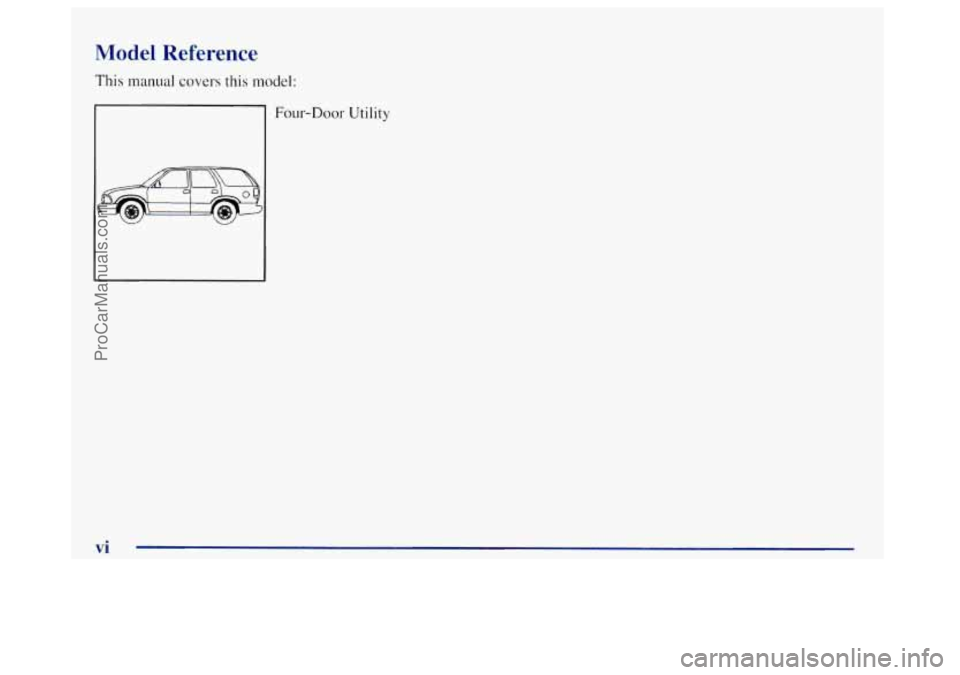
Model Reference
This manual covers this model:
Four-Door Utility
ProCarManuals.com
Page 13 of 380
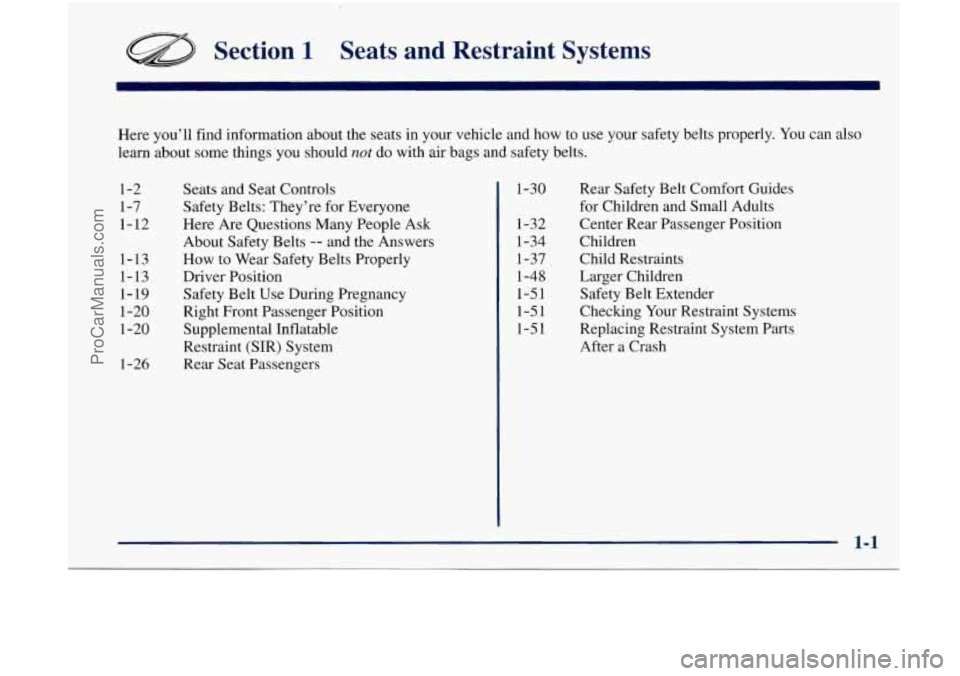
Section 1 Seats and Restraint Systems
Here you’ll find information about the seats in your vehicle\
and how to use your safety belts properly. You can also
learn about some things you should
not do with air bags and safety belts.
1-2
1-7
1- 12
1-13 1-13
1-19
1-20
1-20
1-26
Seats and Seat Controls
Safety Belts: They’re for Everyone
Here Are Questions Many People Ask
About Safety Belts
-- and the Answers
How to Wear Safety Belts Properly
Driver Position
Safety Belt Use During Pregnancy
Right Front Passenger Position
Supplemental Inflatable
Restraint (SIR) System Rear Seat Passengers
1-30
1-32 1-34
1-37
,
1-48
1-5 1
1-5 1
1-5 1
Rear Safety Belt Comfort Guides
for Children and Small Adults
Center Rear Passenger Position
Children
Child Restraints
Larger Children Safety Belt Extender
Checking Your Restraint Systems
Replacing Restraint System Parts
After a Crash
1-1
ProCarManuals.com
Page 14 of 380

Seats and Seat Controls
This section tells you about the seats -- how to adjust
them, and fold them up and down.
Power Driver’s Seat
The control pad is on the side of your driver’s seat.
Manual Passenger’s Seat
Move the lever under the front of the passenger’s seat
toward the driver’s door to unlock it. Slide the seat to
where you want
it. Then release the lever and try to
move the seat with your body to make sure the seat is
locked into place.
1-2
ProCarManuals.com
Page 15 of 380

Horizontal Control: Raise the front of the seat by
raising the forward edge of
the button. Lower the front
of the seat by lowering the forward edge of the button.
Move the seat forward by moving the whole button
toward the front
of the vehicle.
Raise the rear of the seat by raising
the rear edge of the
button. Lower the rear of the seat by lowering the rear
edge of the button. Move the seat rearward by moving
the whole button toward
the rear of the vehicle.
Moving the whole button up or down raises or lowers
the whole seat.
Vertical Control: Move the reclining front seatback
rearward by moving the button toward the rear
of the
vehicle. Move the seatback forward by moving the
button toward the front of the vehicle.
Heated Front Seats (Option)
If you have this feature,
the control is located on
the side of the seat. This
feature
will quickly heat
the lower cushion and
lower back of the driver
and front passenger seats
for added comfort.
Press the lower part
of the switch down to turn the
heater on low. Press the upper part of
the switch to turn
the heater on high. Put the switch
in the center position
to turn the heater off.
ProCarManuals.com
Page 16 of 380
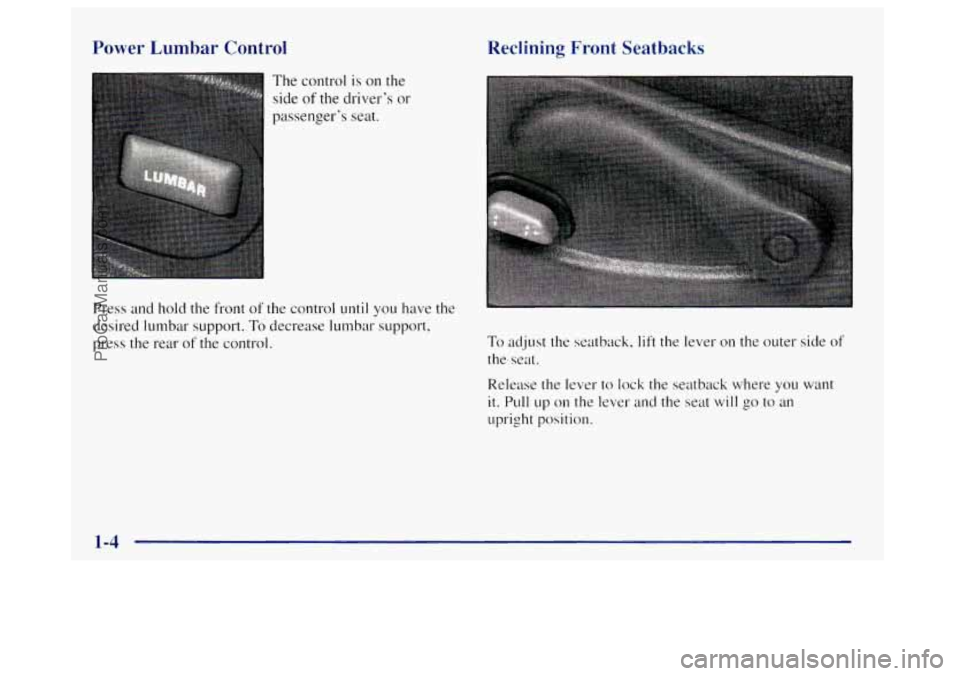
Power Lumbar Control
The control is on the
side
of the driver’s or
passenger’s seat.
Press and
hold the front of the control until you have the
desired lumbar support.
To decrease lumbar support,
press the rear of the control.
Reclining Front Seatbacks
To adjust the seatback, lift the lever on the outer side of
the seat.
Release the lever
to lock the seatback where you want
it. Pull LIP on the lever and the seat will go to an
upright position.
1-4
ProCarManuals.com
Page 17 of 380
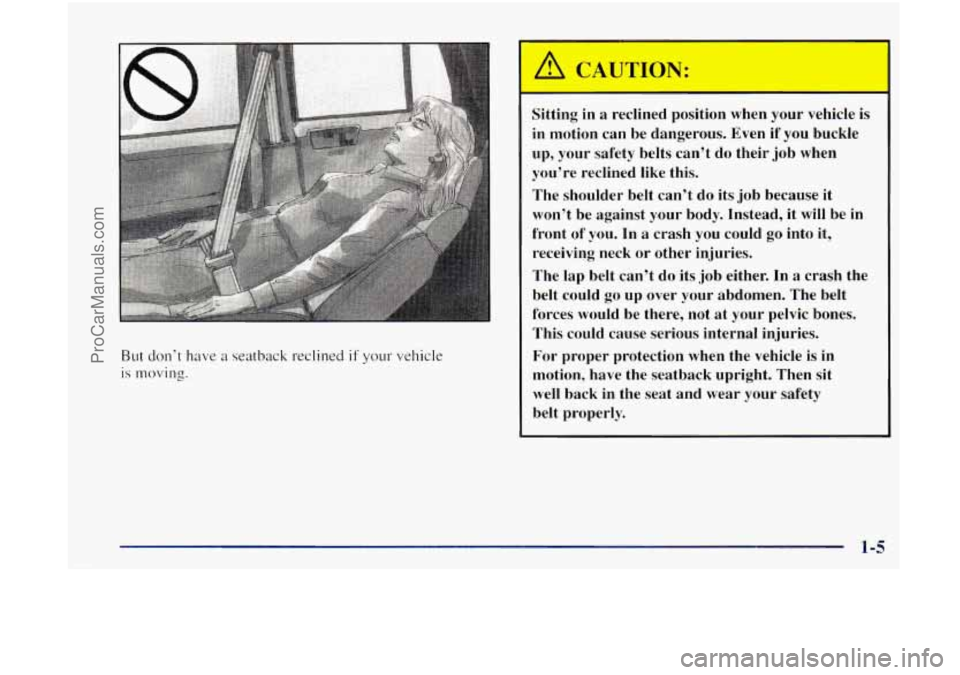
But don’t have a seatback reclined if your vehicle
is moving.
Sitting in a reclined position when your vehicle is
in motion can be dangerous. Even if you buckle
up, your safety belts can’t do their job when
you’re reclined like this.
The shoulder belt can’t do its job because it
won’t be against your body. Instead, it will be
in
front of you. In a crash you could go into it,
receiving neck or other injuries.
The lap belt can’t do its job either. In a crash the
belt could
go up over your abdomen. The belt
forces would be there, not at your pelvic bones.
This could cause serious internal injuries.
For proper protection when the vehicle is in
1 motion, have the seatback upright. Then sit
well back in the seat and wear your safety
belt properly.
ProCarManuals.com
Page 18 of 380

Head Restraints
Slide the head restraint up or down so that the top of the
restraint is closest to the top
of your ears. This position
reduces the chance
of a neck injury in a crash.
The head restraints
tilt forward and rearward also.
Rear Seats
Your vehicle has a folding rear seat which lets you fold
the seatbacks down for
more cargo space.
The rear seat release handles are on the rear
of the
seatbacks. Push back on the seatbacks as you
pull up
on the handles. The head restraint will automatically
fold out of the
way when the seatback is folded down.
To raise the seatbacks, just
lift LIP the seatbacks and
push until they lock in the upright position. Push and
pull
on the seatbacks to check that the latches have
locked
in the upright position. If they haven’t, have
them repaired immediately.
1-6
ProCarManuals.com
Page 19 of 380
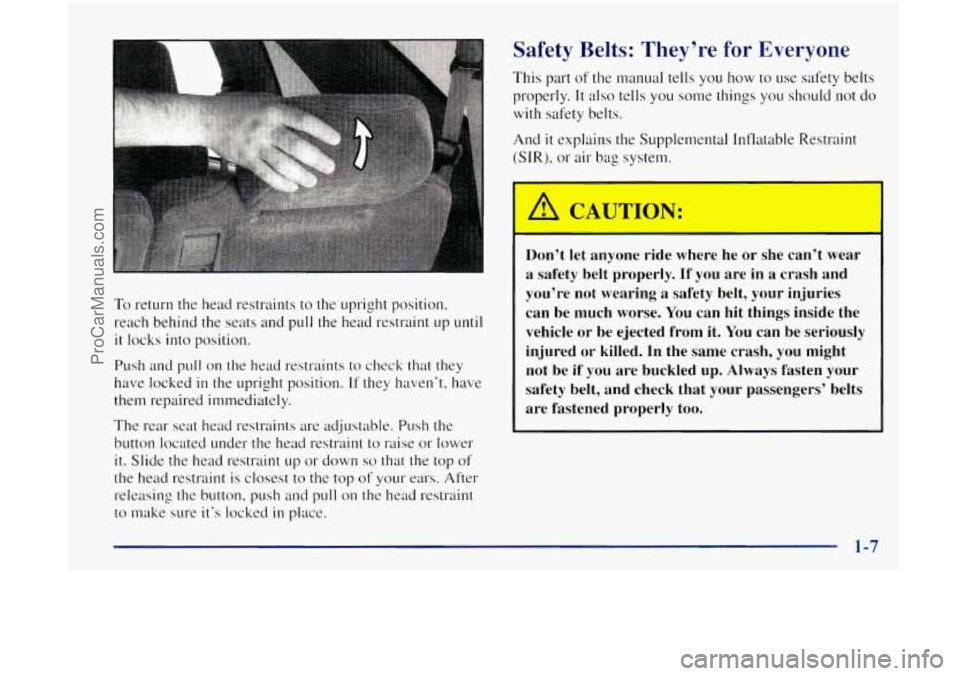
To return the head restraints to the upright position,
reach behind the seats and
pull the head restraint up until
it locks into position.
Push
and pull on the head restraints to check that they
have locked
in the upright position. If they haven’t, have
them repaired immediately.
The rear seat head restraints are adjustable. Push the
button located under the head restraint to raise or lower
it. Slide the head restraint up or down so that the top of
the head restraint is closest to the top of your ears. Aftel-
releasing the button, push and pull
on the head restraint
to make sure it‘s locked
in place.
Safety Belts: They’re for Everyone
This part of the manual tells you how to use safety belts
properly.
It also tells you some things you should not do
with safety belts.
And
it explains the Supplemental Inflatable Restraint
(SIR),
or air bag system.
I A CAUTION:
-
Don’t let anyone ride where he or she can’t wear
a safety belt properly. If you are in a crash and
you’re not wearing a safety belt, your injuries
can be much worse. You can hit things inside the
vehicle or be ejected from it. You can be seriously
injured or killed. In the same crash, you might
not be if you are buckled up. Always fasten your
safety belt, and check that your passengers’ belts
are fastened properly too.
1-7
-
ProCarManuals.com
Page 20 of 380
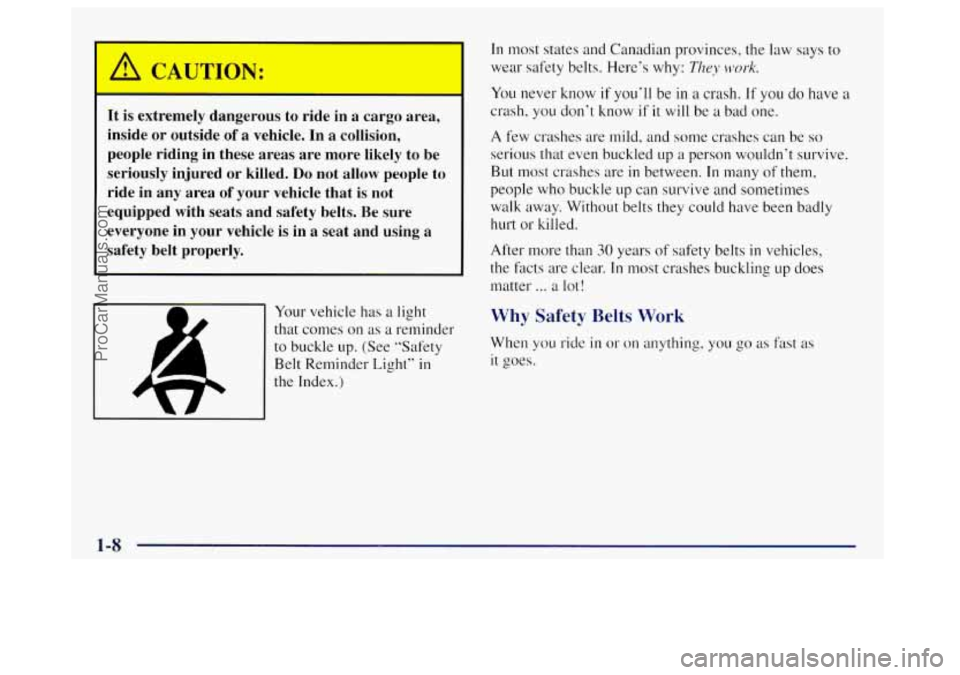
It is extremely dangerous to ride in a cargo area,
inside or outside
of a vehicle. In a collision,
people riding in these areas are more likely to be
seriously injured or killed.
Do not allow people to
ride in any area of your vehicle that is not
equipped with seats and safety belts. Be sure
everyone in your vehicle is in a seat and using a
safety belt properly.
Your vehicle has a light
that comes on as a reminder
to buckle up. (See “Safety
Belt Reminder Light” in
the Index.)
1 -- I
In most states and Canadian provinces, the law says to
wear safety belts. Here’s why:
They work.
You never know if you’ll be in a crash. If you do have a
crash, you don’t know
if it will be a bad one.
A few crashes are mild, and some crashes can be so
serious that even buckled up a person wouldn’t survive.
But
most crashes are in between. In many of them,
people who buckle
up can survive and sometimes
walk away. Without belts they could have been badly
hurt or killed.
After more than
30 years of safety belts in vehicles,
the facts are clear. In most crashes buckling up does
matter
... a lot!
Why Safety Belts Work
When you ride in or on anything, you go as fast as
it goes.
1-8
ProCarManuals.com